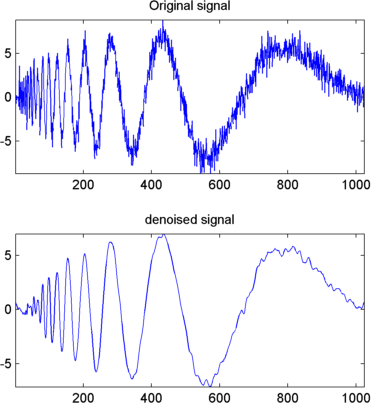1-D Stationary Wavelet Transform
This topic takes you through the features of 1-D discrete stationary wavelet analysis using the Wavelet Toolbox™ software. For more information see Nondecimated Discrete Stationary Wavelet Transforms (SWTs) in the Wavelet Toolbox User's Guide.
The toolbox provides these functions for 1-D discrete stationary wavelet analysis. For more information on the functions, see the reference pages.
Analysis-Decomposition Functions
Function Name | Purpose |
|---|---|
Decomposition |
Synthesis-Reconstruction Functions
Function Name | Purpose |
|---|---|
Reconstruction |
The stationary wavelet decomposition structure is more tractable than the wavelet one. So the utilities, useful for the wavelet case, are not necessary for the stationary wavelet transform (SWT).
In this section, you'll learn to
Load a signal
Perform a stationary wavelet decomposition of a signal
Construct approximations and details from the coefficients
Display the approximation and detail at level 1
Regenerate a signal by using inverse stationary wavelet transform
Perform a multilevel stationary wavelet decomposition of a signal
Reconstruct the level 3 approximation
Reconstruct the level 1, 2, and 3 details
Reconstruct the level 1 and 2 approximations
Display the results of a decomposition
Reconstruct the original signal from the level 3 decomposition
Remove noise from a signal
1-D Analysis
This example involves a noisy Doppler test signal.
Load a signal.
From the MATLAB® prompt, type
load noisdopp
Set the variables. Type
s = noisdopp;
For the SWT, if a decomposition at level
kis needed,2^kmust divide evenly into the length of the signal. If your original signal does not have the correct length, you can use thewextendfunction to extend it.Perform a single-level Stationary Wavelet Decomposition.
Perform a single-level decomposition of the signal using the
db1wavelet. Type[swa,swd] = swt(s,1,'db1');
This generates the coefficients of the level 1 approximation (swa) and detail (swd). Both are of the same length as the signal. Type
whos
Name Size Bytes Class noisdopp1x10248192double arrays1x10248192double arrayswa1x10248192double arrayswd1x10248192double arrayDisplay the coefficients of approximation and detail.
To display the coefficients of approximation and detail at level 1, type
subplot(1,2,1), plot(swa); title('Approximation cfs') subplot(1,2,2), plot(swd); title('Detail cfs')
Regenerate the signal by Inverse Stationary Wavelet Transform.
To find the inverse transform, type
A0 = iswt(swa,swd,'db1');
To check the perfect reconstruction, type
err = norm(s-A0) err = 2.1450e-14
Construct and display approximation and detail from the coefficients.
To construct the level 1 approximation and detail (
A1andD1) from the coefficientsswaandswd, typenulcfs = zeros(size(swa)); A1 = iswt(swa,nulcfs,'db1'); D1 = iswt(nulcfs,swd,'db1');
To display the approximation and detail at level 1, type
subplot(1,2,1), plot(A1); title('Approximation A1'); subplot(1,2,2), plot(D1); title('Detail D1');
Perform a multilevel Stationary Wavelet Decomposition.
To perform a decomposition at level 3 of the signal (again using the
db1wavelet), type[swa,swd] = swt(s,3,'db1');
This generates the coefficients of the approximations at levels 1, 2, and 3 (
swa) and the coefficients of the details (swd). Observe that the rows ofswaandswdare the same length as the signal length. Typeclear A0 A1 D1 err nulcfs whos
Name Size Bytes Class noisdopp1x10248192double arrays1x10248192double arrayswa3x102424576double arrayswd3x102424576double arrayDisplay the coefficients of approximations and details.
To display the coefficients of approximations and details, type
kp = 0; for i = 1:3 subplot(3,2,kp+1), plot(swa(i,:)); title(['Approx. cfs level ',num2str(i)]) subplot(3,2,kp+2), plot(swd(i,:)); title(['Detail cfs level ',num2str(i)]) kp = kp + 2; end
Reconstruct approximation at Level 3 From coefficients.
To reconstruct the approximation at level 3, type
mzero = zeros(size(swd)); A = mzero; A(3,:) = iswt(swa,mzero,'db1');
Reconstruct details from coefficients.
To reconstruct the details at levels 1, 2 and 3, type
D = mzero; for i = 1:3 swcfs = mzero; swcfs(i,:) = swd(i,:); D(i,:) = iswt(mzero,swcfs,'db1'); endReconstruct and display approximations at Levels 1 and 2 from approximation at Level 3 and details at Levels 2 and 3.
To reconstruct the approximations at levels 2 and 3, type
A(2,:) = A(3,:) + D(3,:); A(1,:) = A(2,:) + D(2,:);
To display the approximations and details at levels 1, 2 and 3, type
kp = 0; for i = 1:3 subplot(3,2,kp+1), plot(A(i,:)); title(['Approx. level ',num2str(i)]) subplot(3,2,kp+2), plot(D(i,:)); title(['Detail level ',num2str(i)]) kp = kp + 2; end
To denoise the signal, use the
ddencmpcommand to calculate a default global threshold. Use thewthreshcommand to perform the actual thresholding of the detail coefficients, and then use theiswtcommand to obtain the denoised signal.Note
All methods for choosing thresholds in the 1-D Discrete Wavelet Transform case are also valid for the 1-D Stationary Wavelet Transform, which are also those used by the Wavelet Analysis app. This is also true for the 2-D transforms.
[thr,sorh] = ddencmp('den','wv',s);
dswd = wthresh(swd,sorh,thr);
clean = iswt(swa,dswd,'db1');
To display both the original and denoised signals, type
subplot(2,1,1), plot(s);
title('Original signal')
subplot(2,1,2), plot(clean);
title('denoised signal')

The obtained signal remains a little bit noisy. The result can
be improved by considering the decomposition of s at
level 5 instead of level 3, and repeating steps 14 and 15. To improve
the previous denoising, type
[swa,swd] = swt(s,5,'db1');
[thr,sorh] = ddencmp('den','wv',s);
dswd = wthresh(swd,sorh,thr);
clean = iswt(swa,dswd,'db1');
subplot(2,1,1), plot(s); title('Original signal')
subplot(2,1,2), plot(clean); title('denoised signal')

A second syntax can be used for the swt and iswt functions, giving the same results:
lev = 5; swc = swt(s,lev,'db1'); swcden = swc; swcden(1:end-1,:) = wthresh(swcden(1:end-1,:),sorh,thr); clean = iswt(swcden,'db1');
You can obtain the same plot by using the same plot commands as in step 16 above.